| Tweet |  |
BLOX is trading $12.67, down 38.3% off of earnings, with IV30™ down 12.3%. The Symbol Summary is included below.
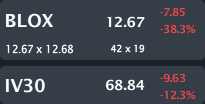
Provided by Livevol
Conclusion
The option market totally mis-priced risk in earnings for BLOX, and there were several (four to be exact) ways to see how this curious option pricing may in fact have been too low before the fact (before the huge drop today).
The news today is pretty simple: bad earnings results. Here is a quick snippet:
---
Infoblox (NYSE: BLOX), an automated network control solutions company, reported Thursday that its current CEO and president Robert Thomas will be stepping down.
[]
In addition to the announcement that Thomas will be leaving the company, Infloblox also released its fiscal 2014 third quarter results. Despite posting a $0.03 EPS beat vs. consensus in the third quarter, the company reduced its guidance for the third straight quarter.
Source: Benzinga via Yahoo! Finance: Why Are Shares Of Infoblox Tumbling?, written by Eric Niederer
---
The Charts Tab (all-time) is included below.
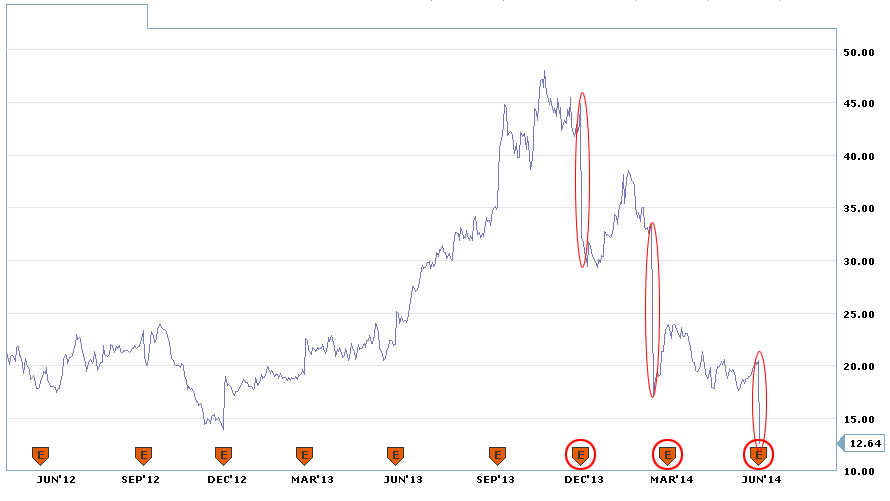
Provided by Charles Schwab optionsXpress
Note that for the prior two earnings cycles, the stock gapped down pretty huge off of the news. Today, of course, we have the hindsight of a third consecutive earnings drop. The first two drops are circumstantial evidence exhibits #1 and #2 that the option market should have seen elevated risk into this earnings release.
But, there's more... Let's turn to the two-year IV30™ chart in isolation, below.
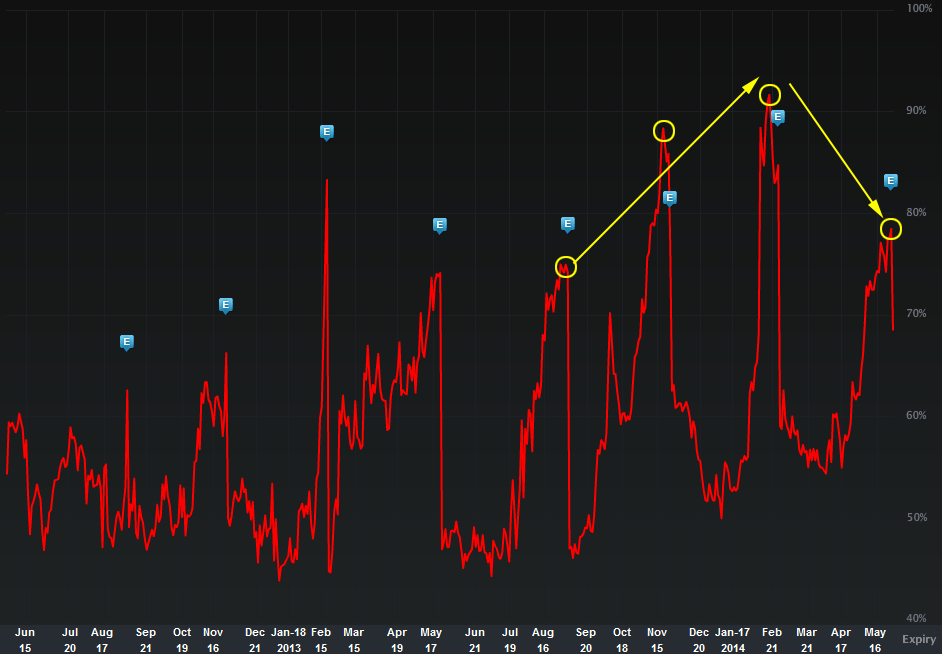
Provided by Livevol
The implied volatility is the forward looking risk in the equity price as reflected by the option market (IV30™ looks forward exactly 30 calendar days). The blue "E" icons represent earnings dates. Note that for the prior three earnings cycles, the implied volatility was rising relative to the last earnings release. In English, the option market reflected higher and higher risk into earnings.
But now look at the volatility level reached ahead of this last earnings release. It actually dropped. In fact, while the prior earnings release should an IV30™ of ~92%, yesterday BLOX IV30™ was just 78%.
Exhibit #3 in circumstantial evidence that the option market should have priced risk higher is unclear rationale for a drop in risk for this earnings cycle relative to the prior three.
There's a fourth piece of evidence that the option market was under-pricing risk and we could have known ahead of time, and we see it in the skew.
The Skew Tab snap (below) illustrates the vols by strike.
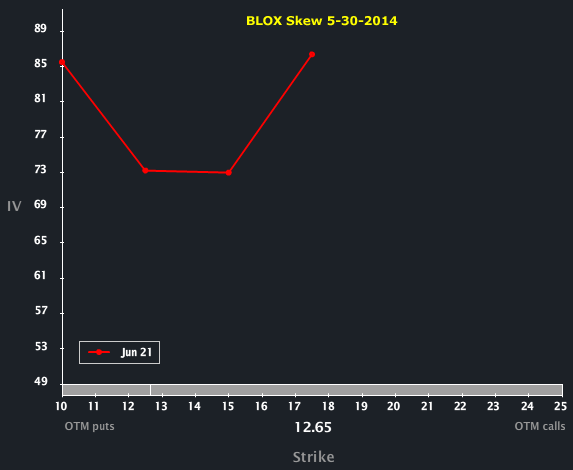
Provided by Livevol
The skew as of today is parabolic. In English, the option market reflects two-tail risk right now (post earnings). but what about before earnings?
Let's turn to the Skew Tab two days ago, below.
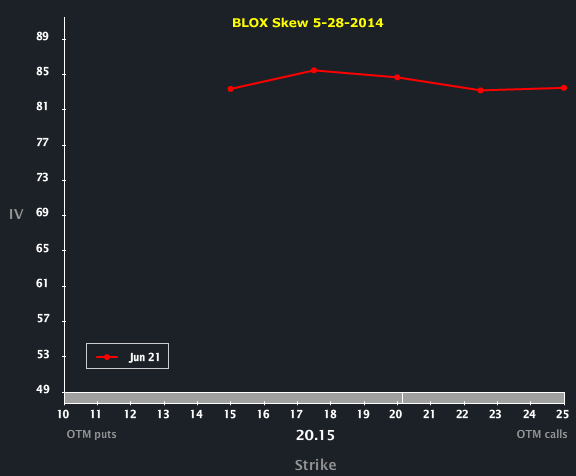
Provided by Livevol
Note that ahead of earnings the skew was totally flat. This is abnormal for a "normal" day and wildly abnormal for an earnings day. The option market not only reflected to little risk int he equity price in general (IV30™ was too low), but it didn't reflect any tail risk.
Well, there was tail risk... and it was realized.
To read more about skew, what is and why it exists you can click the title below:
Understanding Option Skew -- What it is and Why it Exists.
Finally, the Options Tab is included below.
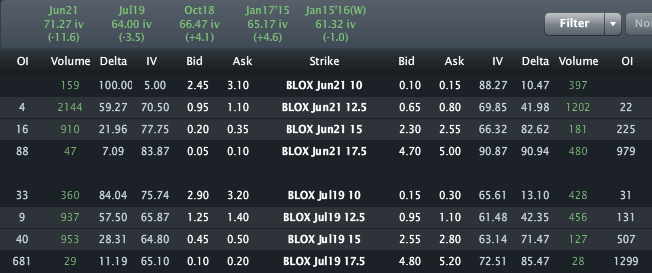
Provided by Livevol
As of right now the option market prices a stock price range of [$10.80, $14.20] for BLOX by the end of trading on Jun 20th.
- If you believe the stock will be outside that range on expiry or any date before then, then you think the volatility is too low.
- If you believe that range is too wide, and that the stock will definitively be in that range on expiration, then you think volatility is too high.
- If you're not sure, and can make an argument for either case, then you think volatility is priced just about right.
This is trade analysis, not a recommendation.
Follow @OphirGottlieb
Tweet
Legal Stuff:
Options involve risk. Prior to buying or selling an option, an investor must receive a copy of Characteristics and Risks of Standardized Options. Investors need a broker to trade options, and must meet suitability requirements.
The information contained on this site is provided for general informational purposes, as a convenience to the readers. The materials are not a substitute for obtaining professional advice from a qualified person, firm or corporation. Consult the appropriate professional advisor for more complete and current information. I am not engaged in rendering any legal or professional services by placing these general informational materials on this website.
I specifically disclaim any liability, whether based in contract, tort, strict liability or otherwise, for any direct, indirect, incidental, consequential, or special damages arising out of or in any way connected with access to or use of the site, even if I have been advised of the possibility of such damages, including liability in connection with mistakes or omissions in, or delays in transmission of, information to or from the user, interruptions in telecommunications connections to the site or viruses.
I make no representations or warranties about the accuracy or completeness of the information contained on this website. Any links provided to other server sites are offered as a matter of convenience and in no way are meant to imply that I endorse, sponsor, promote or am affiliated with the owners of or participants in those sites, or endorse any information contained on those sites, unless expressly stated.



No comments:
Post a Comment